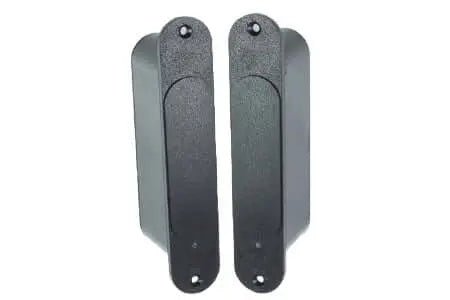SDC
SDC Security Door Controls WPT Wireless Power Transfer Device
SDC Security Door Controls WPT Wireless Power Transfer Device
Couldn't load pickup availability
SDC Security Door Controls WPT Wireless Power Transfer Device
The WPT eliminates unsightly, exposed wires across the door gap that are susceptible to vandalism or breakage thru use and includes a timed trigger to allow for up to 90 seconds of sustained voltage, if required. The WPT transfers power wirelessly across door gaps up to 7mm (a little over 1/4”), and provides more tolerance in lining up the transmitter and receiver vertically and horizontally than inductive power transfer devices.
DATASHEET ATTACHED - CLICK HERE
The WPT uses a radio frequency (RF) transmitter to send energy wirelessly across the door gap to a RF receiver that converts the energy to DC voltage - to power electrified locks and latches. Retrofitting electrified locks into openings with existing wood doors is simpler and less time consuming – core drilling the door is not required. Works well with steel doors, too. Plus, unlike competitive wireless power transfer devices that use magnetic induction for the power transfer, the WPT’s RF technology* also allows for transfer of latchbolt monitoring, REX or data signals. WPT Wireless Power Transfer Device • No door core drilling required • Transfer of latchbolt monitoring, REX or data signals • Door Status Output • No more broken wires, no moving parts • Dual voltage output 12VDC or 24VDC field selectable • For failsecure electrified locks, latches or other door hardware requiring up to 600mA @ 12VDC or 300mA @ 24VDC • For intermittent duty, but can provide up to 90 seconds of sustained voltage • Flexible installation - can be mounted on top of frame, latch side or hinge side with up to 1/4” door gap • UL 1034 and UL 10C 3 hrs fire-rated, FCC Part 15 Compliant
Input Power (Frame Side) 600mA @ 24VDC Output Power (Door Side) 600mA/300mA @ 12/24VDC {Field Selectable} Maximum Door Gap 1/4” (~7mm) Maximum Tolerance with 3/16” (5mm) Gap Horizontal < 5/64" (2mm) Vertical < 5/64" (2mm) Dry Inputs (Frame Side) (2) Door Unlock Trigger (Timed) 1. 4 Second Fixed 2. 1-90 Seconds Manual SPECIFICATIONS* Dry Inputs (Door Side) (2) Relay Activation for REX, Latch Status, etc. Dry Outputs (Frame Side) (2) SPDT Relay, 1A @ 30VDC (2) Solid State Relay, N/O 100mA @ 60VDC LED Indicators: Frame & Door Side Operating Temperature -4°F – 140°F(-20°C – 60°C) Compliance: UL1034; UL10C for 3 Hours; FCC Part 15 Transmitter Receiver Radio waves travel through air Electricity flowing into transmitter antenna makes electrons vibrate, producing radio waves Radio waves make electrons vibrate in receiver antenna to produce electric current DRILL JIG FOR WPT The WPT drill jig assembly provides an economical method preparation for particle filled or solid wood doors to accommodate the installation of the Wireless Power Transfer device. SDC paired with JustDoorToolz to provide a perfect sized Jig for the WPT installation (part# SDC-WPT), sold at www.JustDoorToolz.com. ACCESSORIES * Note – For Use with Fail-Secure (Power to Unlock) Locks Only. Not intended for Continuous Dogging!
* So how is RF wireless charging DIFFERENT from induction? Radio frequency wireless charging technology utilizes radio frequencies to charge a device. While there are several different forms of wireless charging technologies, RF wireless charging is different in that it uses electromagnetic waves, rather than induced magnetic fields (induction). 1. Radio frequency wireless charging differs from magnetic induction first and foremost by the physical character of each technology. Inductive charging uses an electromagnetic field generated by a coil. RF, on the other hand, has a receiver based on electronic circuitry. 2. Induction wireless charging, requires transmitter and receiver for exact alignment or placement for effective charging. RF, on the other hand, is not limited by positioning for effective wireless transfer.
Share


